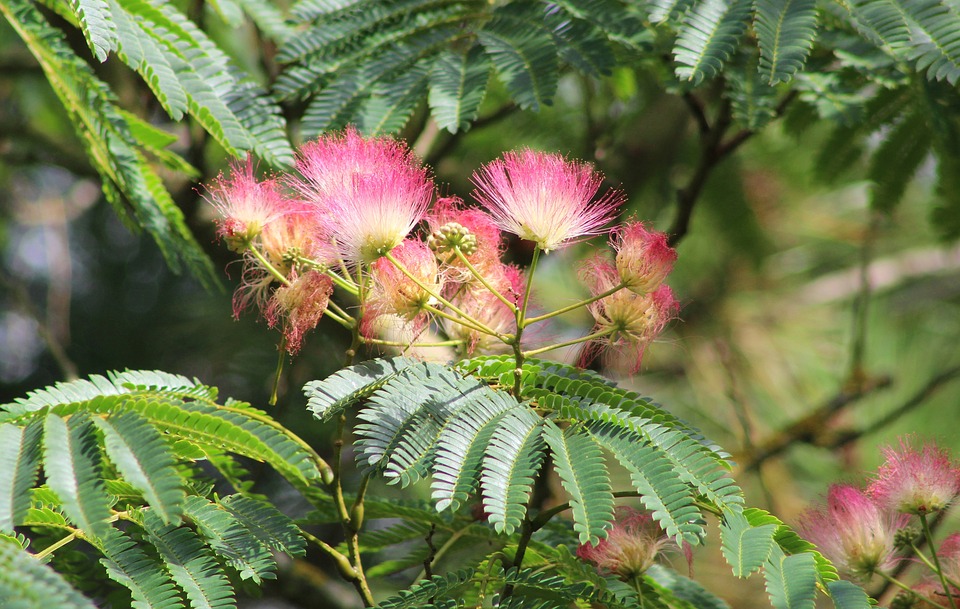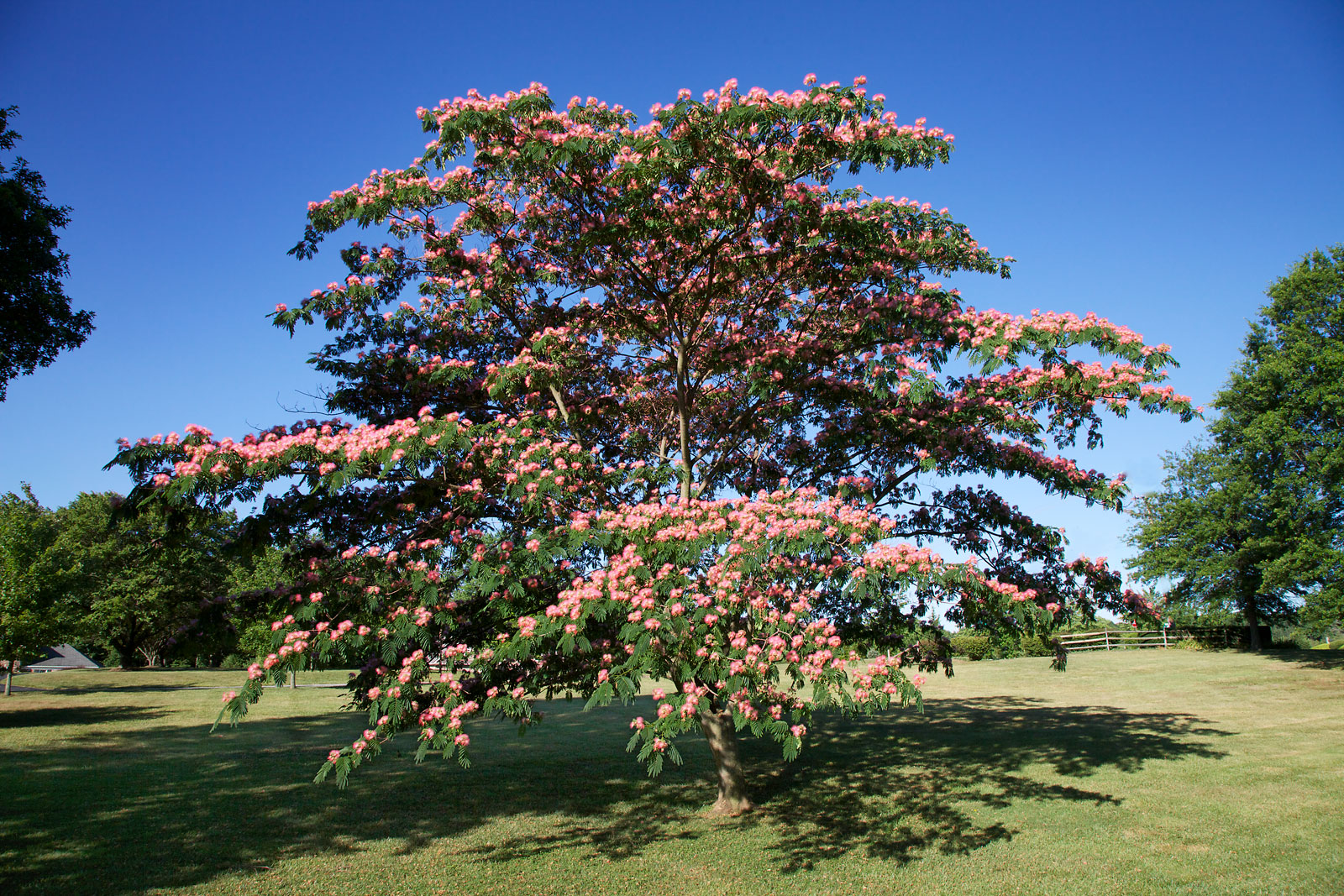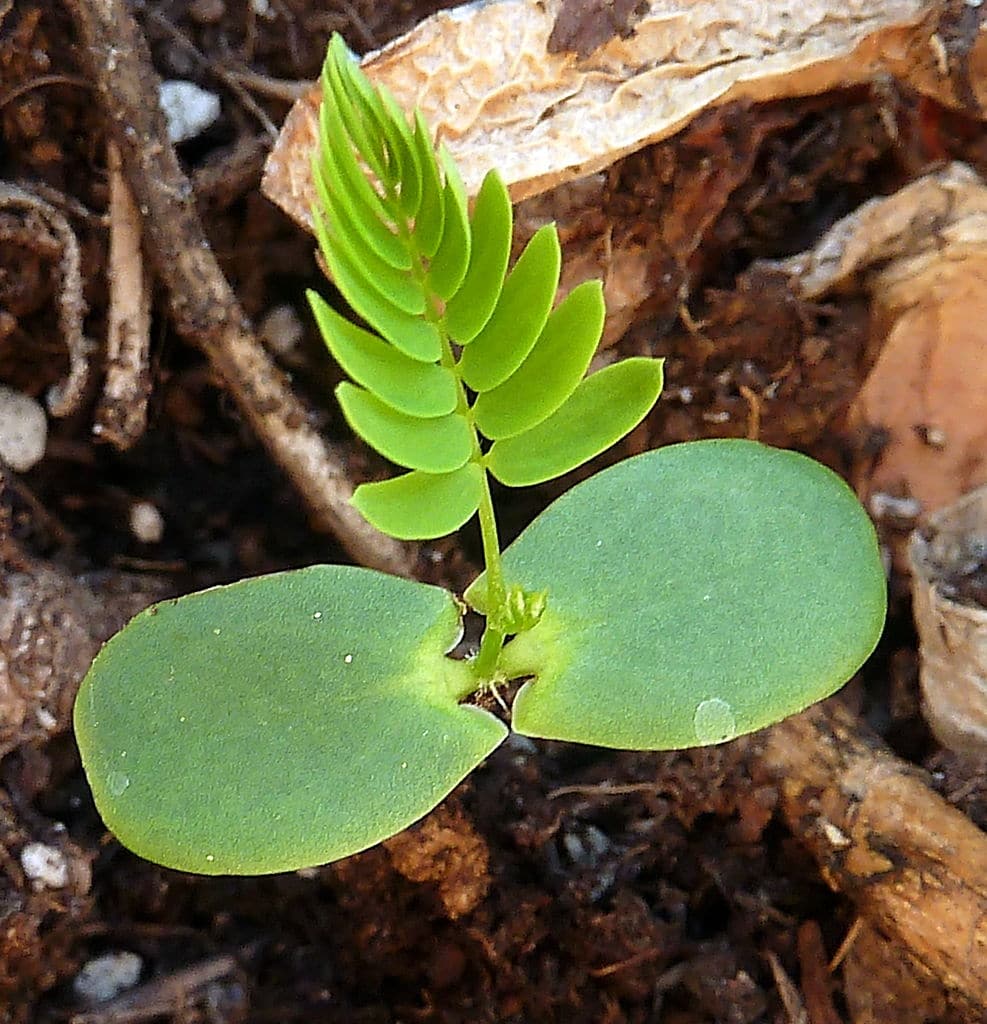
La Albizia julibrissin It is one of the ornamental trees that are most cultivated in regions with a temperate-warm climate. Its glass, when opened, casts a pleasant shade over time, something that is certainly appreciated as it helps us better withstand the summer heat. In addition, although it can reach an interesting height, its trunk does not thicken too much, making it ideal for small or medium-sized gardens.
Its maintenance is not complicated; in fact, it does not usually have problems with pests or diseases, and it is capable of withstanding periods -short, yes- of drought.
What is the origin and characteristics of the Albizia julibrissin?

Image sourced from Flickr/David Illig
La Albizia julibrissin, known as the silk tree, acacia with silky flowers (not to be confused with the trees of the genus Acacia, as they are different), or acacia of Constantinople, It is a species native to Southeast and East Asia., specifically from eastern Iran to China and Korea. It was described by Antonio Durazzini and published in »Magazzino toscano» in 1772.
It is a deciduous tree, whose maximum height is 15 meters. It develops a wide and wide crown, composed of thin branches from which bipinnate leaves 20 to 45cm long by 12 to 25cm wide, divided into 6 to 12 pairs of pinnae or leaflets, which are green or brown. dark in variety Albizia julibrissin 'Summer chocolate'. The trunk is more or less straight, with dark gray bark turning greenish as it ages.
Blooms in spring. The flowers are grouped in terminal panicles, pinkish in color. The fruit is a legume about 15cm long by 3cm wide, containing hard, dark brown, ovoid seeds that ripen in mid/late summer.
What uses does it have?

La Albizia julibrissin It is a very decorative and easy to care for plant, which is why its most widespread use is precisely the ornamental. But it is interesting to know that it is also used as medicinal: the bark of its trunk has anthelmintic properties, that is, antiparasitic, and also serves to heal wounds.
If you have cattle, you can give them the seeds, as they are edible for them. And lastly, the flowers are rich in nectar, which will attract bees.
What are the care of the acacia of Constantinople?

Image sourced from Wikimedia/David J. Stang
They are not very complicated. For it to be alright it needs to be in full sun, receive water about 2-3 times a week (less during the autumn-winter), and if it is fertilized regularly during the spring and summer, it will surely grow with great health and strength.. For this you can use any type of fertilizer, being more recommended the organic ones (guano, compost, algae,...) especially if you want to take advantage of its benefits.
If we talk about the ground, it is not demanding. I can tell you that I have seen specimens planted in alkaline soil, with not too good drainage and somewhat poor in nutrients, and they were quite good. So you don't have to worry about that 🙂 . In any case, you can grow it in a pot with universal substrate, and even as a bonsai in akadama, although it is not uncommon that it does not flower in these conditions or that it does so little.
Does not need pruning, but obviously if you have it in a container, it is advisable to prune it from time to time, at the end of winter, in order to control its growth.
With regard to pests and diseases, you should know that it does not have any remarkable ones. Maybe some cochineal, but nothing serious. You can treat it with diatomaceous earth, which is a highly effective natural insecticide, but it is not essential.

Image sourced from Wikimedia/Philmarin
To get new copies its seeds are sown in spring or autumn, first subjecting them to a pregerminative treatment known as thermal shock. It consists of placing them in a glass of boiling water for a second, and immediately after 24 hours in another glass of water at room temperature. After that time, they are planted in pots or any other seedbed outside, in semi-shade, so that they germinate in about two or three weeks maximum.
Otherwise, it resists frosts down to -18ºC, but on the other hand it could not live in climates where the temperature never dropped below 0 degrees.
Hello Monica.
We have two: the normal Acacia of Constantinople and the Summer Chocolat. They are very pretty and showy, but every spring they are attacked by plagues of white flying bugs that give the tree a whitish appearance (it fills up). We treat them and they go away, but then in summer they proliferate again. It also attacks the flowers in their formation and the result is that it gives much less than usual. We are thinking of doing a preventive treatment every spring to prevent them from proliferating. What do you think? Could I send you a photo of the parasite, to see if you can recommend a pesticide?
Thank you very much for your article and the photos, a luxury to be able to read you!
A cordial greeting,
GALANTE NACHO
Hello again 🙂
Are the trees you have very big? I ask because if they are rather small (2 meters or less) still, I highly recommend diatomaceous earth. First, all the leaves are wet -of course, when the sun is already hiding- and then this soil is poured, which is actually a white powder made of algae composed of silica.
When they come into contact with the parasite, they pierce it and it dies. It is one of the best -which is natural- that is on the market right now. It also serves to repel and eliminate ants, fleas, ticks,... and it has its share of fertilizer.
They sell it on amazon at a good price.
Anyway, if you want you can send the photos from the Facebook page: https://www.facebook.com/Todo-%C3%81rboles-2327159090862738/
And thanks for your words hehe
Regards!
Hello Monica.
The normal Acacia will measure 6 or 7 meters, the Summer I think 3. I pass the information on to my brother who lives in Gredos. What time of year is this usually done?
It seems like a good solution and also quite ecological…
Let's see if I have photos that show the parasite well and I'll send them to you.
Thank you for your wise advice and best regards!
GALANTE NACHO
Hola!
You can do it at any time of the year, but avoid doing it when it is going to rain, as it does not leave any residue.
In any case, potassium soap or neem oil are also good, but these taking into account their price and the size of the trees would be a bit expensive hehe 🙂
If you want, send me the photos to the mail: monicasencina@gmail.com
Regards!
Hello, good afternoon! I am from Mexico, and I have some seeds, but the truth is when I saw the photo of the bush it was in a pot, but from what you explain it is not possible and more so because of the size…. I am right?
Hello Lizssan.
Albizia can be kept in a pot as a shrub, but see if the plant you saw was a Caesalpinia. They are quite similar when they are young 🙂
Regards!
Hello
I have an albizia and the trunk is full of verdigris
What can be?
Thank you very much
All the best
Hi Luis.
The verdigris appears due to humidity. If it is very high, or if it has been raining very often lately, it is normal for the trunk and branches to fill with it.
In any case, if you suspect that it is not that or have doubts, write me again. 🙂
Regards!
Hello good afternoon, I wanted to ask what is good to combat the ants of a Constantinople acacia that is hollowing out. Thank you.
Hi Caroline.
You can rub the trunk with a half lemon. This repels the ants.
In any case, these insects usually appear when the plant has aphids. And these are removed with yellow sticky traps that are sold in nurseries.
Greetings.
Hello, good afternoon.
I am writing to ask for your help, since I have an Albizia julibrissin and until recently it was very beautiful. After 1 year planted, some branches suddenly turned completely yellow, she lost them and from that moment all the others have dried up. In the bark they have come out a kind of small very small lumps that can be removed with the nail. We don't know what's wrong with her and not even the gardener who brought her to us has been able to tell us what's wrong with her. It has sufficient irrigation and is in the sun. Please can you give me some advice? I am very sorry that I cannot help her and I do not want her to die. I can send you pictures if she helps you.
Thank you very much in advance.
A greeting.
Hi Maria de los Llanos.
If those little bugs can be removed with a fingernail, they are probably mealybugs. You can eliminate them with an anti-cochineal insecticide, or with diatomaceous earth that they sell on Amazon for example.
Regards!
Thanks a lot! Let's try.
Hello, well, I have a mimosa for 2 years and it is quite large... it has green spots on the trunk as if it were wet and it gives me the feeling that it is cracking, what could it be? thank you
Hello Auri.
Has it rained a lot lately in your area? It could be that the tree has had a great excess of water, and that it is cracking because of it, perhaps due to some fungal infestation. Fungi like humid environments, and if the plant is already a bit weak, well... there they go.
My advice: treat the tree with fungicide. Follow the instructions for use that will be indicated on the container, but once you have diluted it in water, water with it. If you can, the ideal would be to introduce it inside the trunk of the tree, with the help of a syringe, through any small hole or crack that it has, in case it had one.
Luck!
Goodnight.
I have a flowerbed with a depth of 2 meters with arable land and well decomposed manure. I was wondering if it's a good idea to plant a summer chocolate in it. It has a high sun exposure and exuding irrigation.
I have been told that the roots of acacias are very invasive. Will I have problems in the future???
Congratulations for your page, excellent work.
Thanks ☺️
Hi Luis.
Thank you very much for your words.
Well, first of all, you have to know that summer chocolate is actually an Albizia, not an Acacia 🙂
His scientific name is Albizia julibrissin' Summer Chocolate'.
The good thing about this variety of albizia is that it is slimmer and takes up less space than others, so you shouldn't have any problems.
Regards!
Hello…we have a constantinople acacia but, but we are afraid that its roots will cause us problems in the construction because our garden is not very big, could its roots cause problems? Thank you very much in advance for your answer
Hello Angelica.
How many meters is it from the building? If it is at least 5 meters away there will be no problem.
Greetings.
Hello! I would like to buy one, but I have a couple of doubts, somewhere I read that they are deciduous, it means that in autumn and winter only the trunk will remain! And the other question is that although it is a tree for an average garden, is it possible to plant it in the center of a patio of 4 m per side, surrounded by construction? Thank you very much and have a nice day.
Hi Yan.
Yes, this tree is deciduous.
But it can be kept in small gardens, even in (large) pots.
Greetings.